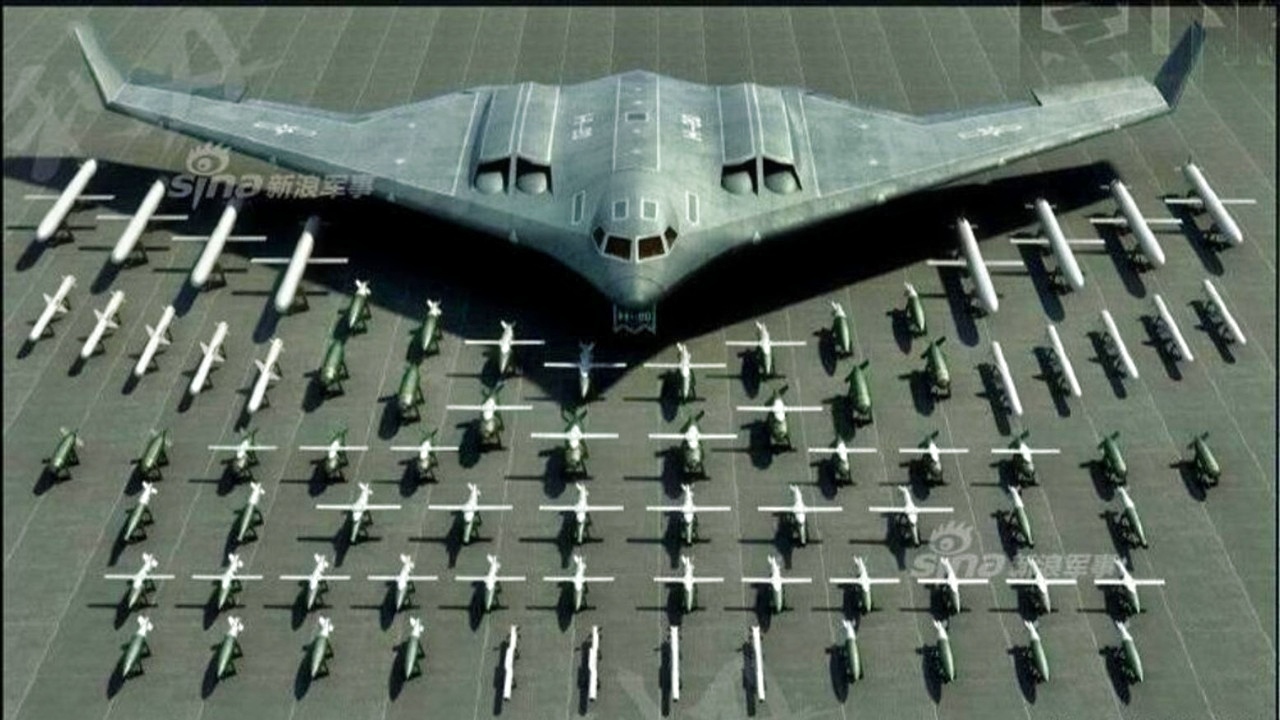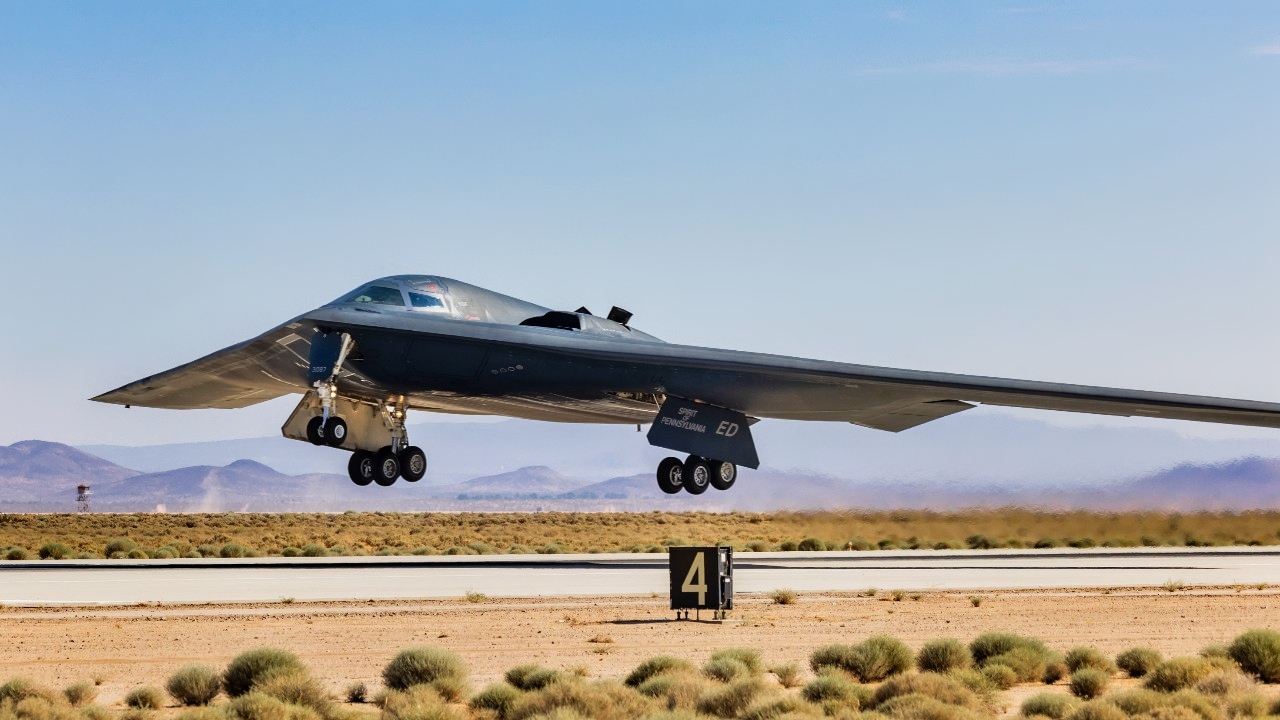Key Points and Summary – China’s H-20 is Beijing’s bid for a true long-range, low-observable strategic bomber, loosely analogous to America’s B-2 and paving the way toward B-21-style capability.
-Designed as a flying-wing stealth platform with both conventional and nuclear roles, it’s expected to exceed 10,000 km in range and reach well beyond the Second Island Chain, with global reach via aerial refueling.

H-20 Bomber. Chinese Internet Social Media Screenshot.
-Though hard details on payload, sensors, and signatures remain opaque, U.S. assessments already treat the H-20 as a coming inflection point: once operational, it will add a survivable deep-strike layer to China’s force and complicate U.S. and allied planning across the Indo-Pacific.
China’s H-20 Bomber: Long-range Strategic Strike
Much of what has been surmised about the H-20 stealth bomber is speculative in nature. But that China’s newest bomber will force a reevaluation of Beijing’s strike capabilities is not.
China’s newest bomber, a stealthy fifth-generation aircraft built by Xi’an Aircraft Corporation, is under development for the People’s Liberation Army Air Force (PLAAF).
Though few of the bomber’s characteristics are publicly known, some aspects of the H-20 can be inferred from its overall design and from how the United States has employed similar aircraft within the United States Air Force.
Like other stealth bombers, the intention of the H-20 is to fill an important and highly niche operational role: long-range strategic bombing with conventional and nuclear weapons.
To support that mission, the H-20’s design is broadly analogous to that of aircraft such as the American B-2 Spirit and B-21 Raider bombers.
An unclassified assessment of China’s H-20, released by the Department of Defense, offers some insight into the H-20 stealth bomber program—and hints at what that platform’s capabilities will be.
“The PRC is developing a new generation of long-range bombers, likely named the H-20. The H-20, which may debut sometime in the next decade, will have a range of more than 10,000 km, enabling the PLAAF to cover the Second Island Chain and into the western region of the Pacific,” the report explains. It adds that “the H-20 bomber’s range could be extended to cover the globe with aerial refueling. It is expected to employ conventional and nuclear weaponry and feature a stealthy design.”
Like its two counterparts in the United States Air Force—the Cold War-era B-2 Spirit bomber and the upcoming B-21 Raider bomber—China’s H-20 is a power-projection tool that can be equipped with both conventional and nuclear weapons—if the stealth bomber can get off Chinese production lines and into the air.

The Spirit of Pennsylvania B-2 Spirit assigned to the 419th Flight Test Squadron lands at Edwards Air Force Base, California, July 17. (Air Force photo by Lindsey Iniguez)
“The PLAAF is seeking to extend its power projection capability with the development of a new H-20 stealth strategic bomber, with official PRC state media stating that this new stealth bomber will have a nuclear mission in addition to filling conventional roles.”
Furthermore, the People’s Liberation Army Air Force is “developing new medium- and long-range stealth bombers to strike regional and global targets. PLAAF leaders publicly announced the program in 2016; however, it may take more than a decade to develop this type of advanced bomber.”
It would not be the first time that a complex stealthy bomber project has had to contend with delayed production timelines: the B-2 bomber also experienced cost overruns and delays, speed bumps attributable to delays in developing the project’s ambitious, cutting-edge technologies.
Though the bomber’s fuselage design was aided by computer modeling, giving the stealth bomber a smoothly rounded appearance in lieu of the boxy stealth contouring of the F-117 Nighthawk, the B-2’s development was nevertheless a significantly complex and novel undertaking. So too will the H-20s.

F-117 at the US Air Force Museum July 2025. Image taken by National Security Journal.
Stealth Capabilities
But what are the H-20’s stealth capabilities exactly? How stealthy is the bomber — and how does it compare to the B-2 or B-21 bombers?
One analysis from the RAND Corporation sheds some light on those questions.
“Judging from recent Chinese military commentary, it would appear that the PLA has already instructed Xi’an [the H-20 bomber] to focus on stealth, as demonstrated by the flying wing configuration, rather than supersonic capabilities,” the report elucidates.
According to Yin Zhuo, China has gained essential expertise on stealth through its development of the J-20 and F-31 stealth fighters.

J-20 Stealth Fighter in China. Image Credit: PLAAF.
Indeed, Yin opined, the H-20 would be on par with the B-2 Spirit in terms of stealth performance. Another military expert, Li Li, assessed that it would be technically demanding to incorporate both stealth and supersonic capabilities into the new bomber because of differences in the required aerodynamic configuration of the aircraft for each capability. This strongly suggests that Xi’an will have to remain focused on stealth.”
If that H-20 analysis holds true, the Chinese bomber would be roughly analogous to a platform rooted in the Cold War, albeit with an updated sensor suite.
One video, released a few years earlier by the PLAAF, offers a brief look at the bomber and is among the few publicly available images of the aircraft.
So while the exact capabilities of the H-20 bomber, including payload capacity, range, and the effectiveness of its stealth design, remain opaque, what is clearer is that with the introduction of the H-20 into service, the People’s Liberation Army Air Force will field a capability roughly on par with America’s first generation of stealth bomber.
H-20: What Happens Next?
Once the H-20 enters operational service with the PLAAF, however, it would force the United States and its allies in the Indo-Pacific region to adjust their force posture, not just by responding to a new platform, but by reacting to a new layer within China’s overall strike capabilities.
With the introduction of the H-20, Beijing can bring a long-range, low-observable, and survivable conventional and nuclear strike platform to bear not just in its near abroad, but potentially much farther afield than previously possible.
Instead of operating at the edges of contested airspace, the H-20 will instead penetrate and survive even in highly contested, deeply defended aerial environments.
About the Author: Caleb Larson
Caleb Larson is an American multiformat journalist based in Berlin, Germany. His work covers the intersection of conflict and society, focusing on American foreign policy and European security. He has reported from Germany, Russia, and the United States. Most recently, he covered the war in Ukraine, reporting extensively on the war’s shifting battle lines from Donbas and writing on the war’s civilian and humanitarian toll. Previously, he worked as a Defense Reporter for POLITICO Europe. You can follow his latest work on X.
More Military
The U.S. Military Is In ‘Crisis’
Canada’s F-35 Stealth Fighter Mistake Is Just Around the Corner
The Mach 2.23 F-4G Wild Weasel Has a Message for the U.S. Air Force










